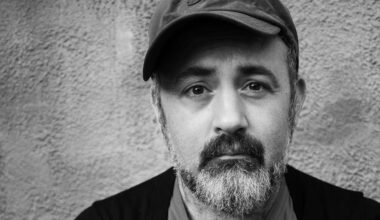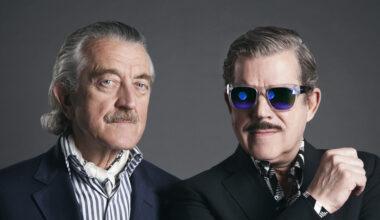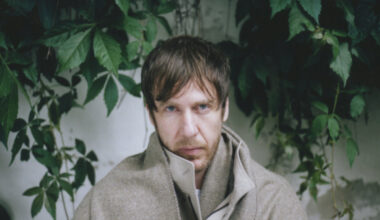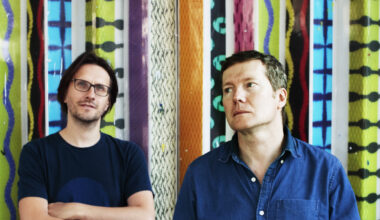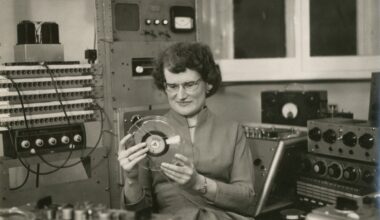Peter Zinovieff, company founder and EMS mastermind
Peter Zinovieff’s family background is filled with extraordinary people who did extraordinary things. His mother was born Princess Sophia Dolgorouky in St Petersburg, just 10 years before the Russian Revolution. She was interned by the Nazis in France during World War II where she helped Jewish prisoners to escape and was posthumously awarded the British Hero Of The Holocaust honour.
All of this and more (she also worked for many years for Laurence Olivier) is documented in ‘Red Princess: A Revolutionary Life’, the 2014 biography of her grandmother by Sofka Zinovieff, Peter’s daughter. On top of all this, Zinovieff’s father was also a Russian aristocrat whose family had fled after the revolution.
Perhaps it’s no surprise then that Sophia’s first child, Peter, born in 1933, would make his mark somehow, though no one could have predicted that the Zinovieff name would be so intimately associated with the electronic music revolution.
Zinovieff studied geology at Oxford, spending seven years there in total as he completed his postgraduate studies. Like many of his contemporaries from Oxford and Cambridge, he was then recruited into the civil service. But his love of electronic music was already stirring, and it would soon replace the professional career his Oxford education had prepared him for.
“At university,” he explains, “I sort of had experimental music groups, and we played around a bit with a tape recorder, that sort of thing. I was always interested in electronic music, and so didn’t last very long as a geologist in the wide world. I was doing horrible work at the Air Ministry, calculating mega deaths after atomic annihilation.”
Not only did his job force him to dispassionately calculate death on an unimaginable scale, a vivid sketch of life during the Cold War for sure, but he soon discovered that it wasn’t actually worth working at all.
“Tax was quite different to nowadays,” he says. “If you had any private income, which my wife did, my income would be taxed at 98 per cent. So it was just not worth earning money. It was called Super Tax.”
It’s worth a small detour here to outline the background of Zinovieff’s privately incomed wife, Victoria Heber-Percy. She and Zinovieff married in 1960. Victoria was the daughter of Jennifer Fry and Robert Heber-Percy, known in the aristocratic circles he moved in as The Mad Boy. He was also rather inconveniently the lover of the eccentric Lord Berners, a man who kept a clavichord in his car and dyed the doves that lived on his estate all manner of exotic colours.
For a short while after Victoria’s birth, Robert and his wife lived with Lord Berners at his family pile, Faringdon House in Oxfordshire, until she left in the face of Robert’s emotional cruelty, taking Victoria with her. Victoria loathed her father, but nonetheless had a sizeable private income. The full story could fill a book… and, of course, it does, Sofka Zinovieff’s ‘The Mad Boy, Lord Berners, My Grandmother And Me’.
“The tax situation was an impetus to give up the horrible work I was doing,” continues Zinovieff. “And then I decided that nobody else in the world was doing electronic music and that nobody even knew what it was. So I thought I’d start doing it. Of course I was wrong, lots of people knew about it.”
And so, as the 1960s got under way, the couple were able to buy a handsome property at 49 Deodar Road in Putney and start a family, and Peter began building his electronic music studio.
“At that time, there was a whole street in Soho called Lisle Street where every single shop, more or less, was selling off ex-Army or ex-RAF equipment,” recalls Zinovieff. “So you had these great big secondhand sine wave oscillators and filters, great manual ones. And they didn’t cost very much… have you seen pictures of my early studio?”

The black and white images that survive of Zinovieff’s studio (often misidentified as the Radiophonic Workshop on the internet) show walls of equipment, impossibly complex, with a rather nice rug on the floor.
“It’s a mad world,” he laughs, “millions of miles of wiring. Which, in my innocent days as I said, not knowing that anybody else did electronic music at all, I thought I was just doing it by myself. Then, gradually, it became known as a studio, and it also became more and more expensive. So instead of cheap lumps of oscillators, I started to get people to make things for me.
“I got someone to make a sequencer after I’d tried to make one out of telephone selectors, but I was no good at electronics. I’m not very patient. Then I met David Cockerell and he made me voltage-controlled equipment, until one day he said, ‘You’ve got to have a computer’, which was a complete madness because nobody had a computer.
“There wasn’t a single person in the world who had a computer. Factories had them, and banks. So this first computer cost, I know exactly, it cost £4,100. Which is about £120,000. So it was an enormous amount of money.”
The computer, a PDP-8 from the Digital Equipment Corporation, was a breakthrough machine for industry, and was used in factories for process control. It wasn’t used for sequencing electronic music… until Peter Zinovieff took delivery of one.
“I went on a course to learn how to use it,” he says, “and by the end I had absolutely no idea what they were talking about. So I went to ask the instructor and, for a crate of whisky, he gave me private tuition. After that, I then spent years just at a Teletype keyboard programming. It was a very slow process.”
Soon after buying the PDP-8, Zinovieff entered into a venture with Delia Derbyshire and Brian Hodgson called Unit Delta Plus. The idea was to create music for commercial clients, advertising and other commissions.
“They were working at the Radiophonic Workshop,” says Zinovieff. “By then, people had heard about what I was doing, and wanted to come and see the rather amazing-looking studio. It did look marvellous actually. Delia and Brian thought they could use the studio with me to make commercial music, so we formed a company, but it never worked out. We produced one jingle for Philips.
“It didn’t work because it was an experimental studio for serious, as it were, classical electronic music. New music by classical composers. Harrison Birtwistle worked a lot with me, for instance. We did many pieces with other classical composers experimenting in electronic music. Unit Delta Plus folded quite quickly, although because of Delia becoming sort of famous, I’m often asked about it. But it wasn’t very important to the EMS history.”
Zinovieff’s next move was to contact Tristram Cary, a composer who had his own electronic music studio in Fressingfield in Suffolk. Cary was well-known for his film and TV work, which began in the late 1950s with his orchestral score for ‘The Ladykillers’. He wrote several pieces for early ‘Doctor Who’ episodes and had just composed the music for the film version of ‘Quatermass And The Pit’ when Zinovieff called.
When it came to creating technology for making electronic music, Cary had similar motivations to Zinovieff; he wanted to improve his own studio, and realised that he and Zinovieff, combined with the electronic wizardry of David Cockerell, could create machines that would make electronic music less technically difficult to compose.
EMS wasn’t a business venture in the traditional sense. There wasn’t a business plan. There was no grand scheme to make a great deal of money for the company’s founders. EMS was simply a vehicle to generate revenue to keep the Putney studio afloat. It was a research facility, the aim of which was to create electronic instruments in order to make music.
“I knew that we had to try to make some money to fund the studio,” says Zinovieff. “I wanted it to be a national studio, so EMS was created in order to keep the studio going. It was never for anything else.”

The idea of popularising electronic music was more of a by-product of its main aims, and making money was framed by the faint but distinct air of aristocratic disregard for commerce that permeated the venture.
“Tristram Cary’s interest was, well, that it was an interesting idea, and he was a friend,” says Zinovieff. “And that was all really. There was nothing commercial in it. David Cockerell was paid for what he designed, but he didn’t have a salary from EMS. Tristram was never paid anything and I wasn’t paid a salary. If we made any money, all that would happen was that new equipment could be bought for the studio. But the more EMS grew, the more cumbersome it became.”
And grow it did, very rapidly. From its first machine, the one-off rack-mounted VCS 1 built for £50 for the Australian composer Don Banks, to the success of the VCS 3 and then the Synthi AKS, EMS expanded at a considerable pace during the early 1970s.
“The factory grew bigger, there were meetings that we had to go to, lots of questions about production and then there were the agents who were selling the gear,” says Zinovieff, ruefully. “Whether it was in America or Europe, each country had its own agent. And that was another terrible grind, you know, having to talk to these ghastly people.”
He clearly didn’t enjoy the world of international business that the success of EMS brought to his door.
“I certainly took as little time doing business as I possibly could,” he says. “I wanted to spend all my time making electronic music.”
By the mid-70s, EMS had evolved and was much altered from the outfit that started out in 1969. Tristram Cary, who was also teaching at the Royal College Of Music, took up a teaching post in Australia in 1974, and David Cockerell went to work for Electro Harmonix in New York and for composer Pierre Boulez at IRCAM, the Institute for Research and Coordination in Acoustics/Music, in Paris.
By now, EMS had entered precarious financial territory, and by the end of 1979 the company finally went bankrupt, after which Zinovieff decamped to the island of Raasay.
Freed of the burden of his responsibility towards EMS, and largely uninterested in raking over the past, he focused on what was coming next. He saw with quite clear vision what that would be as far back as the 60s – computer-controlled music – and worked for a while with Clive Sinclair on the musical applications of the ZX Spectrum.
By the end of the 1980s, his erstwhile technical engineer David Cockerell had designed the first Akai samplers, and computers were at the heart of most recording studios, organising data and controlling musical events. Soon the entire recording process was taking place inside computers, and pretty much everyone had one in their house. Today, we’ve all got one in our pocket. Very few of us own any EMS gear though, including Zinovieff, who doesn’t have a single piece of EMS equipment that went into production.
Peter Zinovieff is a true visionary. Long before the advent of the personal computer, he could see their potential for making music, and focused his considerable energies and intelligence (not to mention cash) on pushing what technology was available to do just that.
The fact that EMS and its range of British synthesisers came into being specifically in order for him to continue his private research into the application of computer technology is the triumph of an indomitable spirit of exploration and ingenuity.
While the EMS years were filled with stress and ultimately the disappointment of the company’s failure, Zinovieff looks back on the birth of the British synthesiser with fondness.
“The 60s were a marvellous time for experiment and enthusiasm,” he says. “Everyone was interested in new things, it wasn’t at all like now. There was a huge air of zest. I think the internet ruined it in a way, because there were a limited amount of people who were doing these new things, and they all knew about each other. Whereas now, there are an infinite amount of people who are doing things and they don’t know each other.”
The world he helped usher in, where the technologies he spent years trying to create are now utterly commonplace, and where the wonder at what were actually quite primitive machines like the VCS 3 is gone, feels disappointing somehow. But like all good futurists, his enthusiasm is still fired by things that haven’t happened yet.
“Let’s see what’s going to happen next,” he says, with a chuckle.


